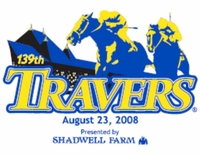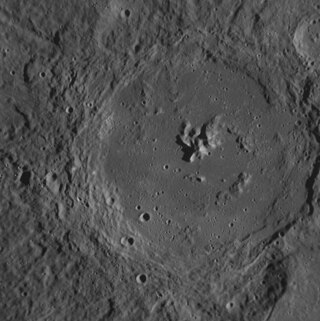
An impact crater is a circular depression in the surface of a solid astronomical object formed by the hypervelocity impact of a smaller object. In contrast to volcanic craters, which result from explosion or internal collapse, impact craters typically have raised rims and floors that are lower in elevation than the surrounding terrain. Lunar impact craters range from microscopic craters on lunar rocks returned by the Apollo program and small, simple, bowl-shaped depressions in the lunar regolith to large, complex, multi-ringed impact basins. Meteor Crater is a well-known example of a small impact crater on Earth.

Meteor Crater or Barringer Crater is an impact crater about 37 mi (60 km) east of Flagstaff and 18 mi (29 km) west of Winslow in the desert of northern Arizona, United States. The site had several earlier names, and fragments of the meteorite are officially called the Canyon Diablo Meteorite, after the adjacent Canyon Diablo.

Crater Lake is a volcanic crater lake in south-central Oregon in the Western United States. It is the main feature of Crater Lake National Park and is famous for its deep blue color and water clarity. The lake partly fills a 2,148-foot-deep (655 m) caldera that was formed around 7,700 years ago by the collapse of the volcano Mount Mazama. No rivers flow into or out of the lake; the evaporation is compensated for by rain and snowfall at a rate such that the total amount of water is replaced every 250 years. With a depth of 1,949 feet (594 m), the lake is the deepest in the United States. In the world, it ranks tenth for maximum depth, as well as third for mean (average) depth.

Peter, Paul and Mary were an American folk group formed in New York City in 1961 during the American folk music revival phenomenon. The trio consisted of tenor Peter Yarrow, baritone Paul Stookey, and contralto Mary Travers. The group's repertoire included songs written by Yarrow and Stookey, early songs by Bob Dylan, and covers of other folk musicians. They were enormously successful in the early- and mid-1960s, with their debut album topping the charts for weeks, and helped popularize the folk music revival. After the death of Travers in 2009, Yarrow and Stookey continued to perform as a duo under their individual names.

The Chicxulub crater is an impact crater buried underneath the Yucatán Peninsula in Mexico. Its center is offshore, but the crater is named after the onshore community of Chicxulub Pueblo. It was formed slightly over 66 million years ago when a large asteroid, about ten kilometers in diameter, struck Earth. The crater is estimated to be 180 kilometers in diameter and 20 kilometers in depth. It is the second largest confirmed impact structure on Earth, and the only one whose peak ring is intact and directly accessible for scientific research.

Pamela Lyndon Travers was an Australian-British writer who spent most of her career in England. She is best known for the Mary Poppins series of books, which feature the eponymous magical nanny.

The Travers Stakes is an American Grade I Thoroughbred horse race held at Saratoga Race Course in Saratoga Springs, New York. It is nicknamed the "Midsummer Derby" and is the third-ranked race for American three-year-olds according to international classifications, behind only the Kentucky Derby and Belmont Stakes. First held in 1864, it is the oldest stakes race in the United States specifically for 3-year-olds, and was named for William R. Travers, the president of the old Saratoga Racing Association. His horse, Kentucky, won the first running of the Travers. The race was not run in 1896, 1898, 1899, 1900, 1911, and 1912.

The far side of the Moon is the lunar hemisphere that always faces away from Earth, opposite to the near side, because of synchronous rotation in the Moon's orbit. Compared to the near side, the far side's terrain is rugged, with a multitude of impact craters and relatively few flat and dark lunar maria ("seas"), giving it an appearance closer to other barren places in the Solar System such as Mercury and Callisto. It has one of the largest craters in the Solar System, the South Pole–Aitken basin. The hemisphere has sometimes been called the "dark side of the Moon", where "dark" means "unknown" instead of "lacking sunlight" – each side of the Moon experiences two weeks of sunlight while the opposite side experiences two weeks of night.

A volcanic crater is an approximately circular depression in the ground caused by volcanic activity. It is typically a bowl-shaped feature containing one or more vents. During volcanic eruptions, molten magma and volcanic gases rise from an underground magma chamber, through a conduit, until they reach the crater's vent, from where the gases escape into the atmosphere and the magma is erupted as lava. A volcanic crater can be of large dimensions, and sometimes of great depth. During certain types of explosive eruptions, a volcano's magma chamber may empty enough for an area above it to subside, forming a type of larger depression known as a caldera.

Patrick Henry Travers is a Canadian rock guitarist, singer and songwriter who began his recording career in the mid-1970s.

Lunar craters are impact craters on Earth's Moon. The Moon's surface has many craters, all of which were formed by impacts. The International Astronomical Union currently recognizes 9,137 craters, of which 1,675 have been dated.

Peter Joseph Travers is an American film critic, journalist, and television presenter. He reviews films for ABC News and previously served as a movie critic for People and Rolling Stone. Travers also hosts the film interview program Popcorn with Peter Travers for ABC News.

Daniel Gimeno Traver is a professional Spanish tennis player who turned pro in 2004, when he was eighteen years old. He reached the final of Casablanca in 2015 and has won 12 Challenger Tour events, achieving a career-high singles ranking of World No. 48 in March 2013.
Travers is a hamlet in southern Alberta, Canada within Vulcan County. It is located approximately 59 kilometres (37 mi) southwest of Highway 1 and 59 kilometres (37 mi) southwest of Brooks.

Saving Mr. Banks is a 2013 biographical drama film directed by John Lee Hancock from a screenplay written by Kelly Marcel and Sue Smith. Centered on the development of the 1964 film Mary Poppins, the film stars Emma Thompson as author P. L. Travers and Tom Hanks as film producer Walt Disney, with supporting performances by Paul Giamatti, Jason Schwartzman, Bradley Whitford, Colin Farrell, Ruth Wilson, and B. J. Novak. Deriving its title from the father in Travers's story, Saving Mr. Banks depicts the author's tragic childhood in rural Queensland in 1906 and the two weeks of meetings during 1961 in Los Angeles, during which Disney attempts to obtain the film rights to her novels.

Joplin is a crater on Mercury. Its name was adopted by the International Astronomical Union (IAU) in 2012, after the American composer Scott Joplin.
















